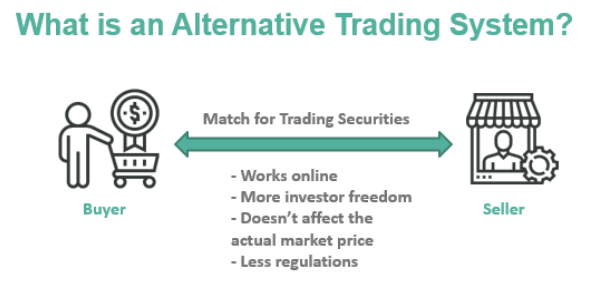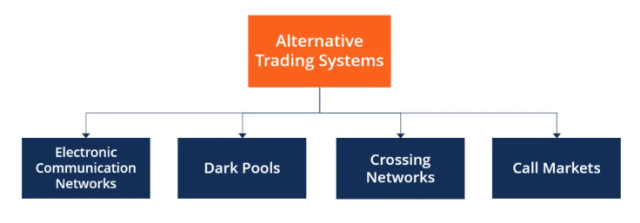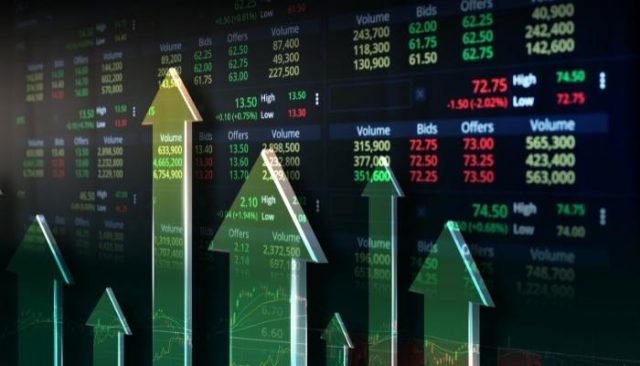Alternative Trading System – Explained By An Expert 2025
By Wilbert S
January 5, 2025 • Fact checked by Dumb Little Man

Alternative trading system, or ATS, is a term used in the United States to describe a computerized system operated by a securities firm that allows customers to trade securities away from the exchanges. Alternative trading systems emerged in the early 2000s in response to the growing fragmentation of liquidity and technology advances that allowed for faster and more efficient execution of orders.
To better the effectiveness of an alternative trading system, we have got Ezekiel Chew, the CEO of Asia Forex Mentor and a seasoned trader. He has over a decade of experience in trading forex and is a highly respected figure in the industry. According to Ezekiel, the alternative trading system is critical in providing two main services:
The first is enabling liquidity providers, such as banks and hedge funds, to trade with each other without the need for a third party. The second provides a venue for the impossible trading activity on traditional exchanges. For example, an ATS may allow for the trading of illiquid securities or the execution of large orders that would be difficult to fill on an exchange.
In this guide, we will discuss an alternative trading system, how ATS works, its examples, and more. So, let’s get right into it.
What is an Alternative Trading System?

An alternative trading system (ATS) is a non-exchange trading platform approved by the Securities and Exchange Commission (SEC). Still, it is not regulated in the same way as exchanges are.
This trading platform connects potential buyers and sellers to find agreeable counterparties. ATS is a service that enables investors and traders to connect their orders. Alternative trading systems are commonly used in the United States and Canada. However, they are classified as broker-dealers.
In the United States, the most widely used type of alternative trading system is Electronic Communication Networks (ECNs). ECNs connect buyers and sellers in the market automatically through an electronic process. The term “ATS” is used by North Americans, while Europeans use Multilateral Trading Facility (MTF).
Understanding Alternative Trading System

A variety of alternative trading systems (ATS) account for a significant proportion of the worldwide volume of publicly listed equities. These European ATS are multilateral trading facilities, ECNs, cross networks, and call networks.
Most of these ATS are not exchanges but broker-dealers rather. Their major objective is to identify transaction participants, which is why they’re frequently referred to as “endpoint identification systems.”
In contrast to some exchanges, ATS does not set rules surrounding subscriber conduct or discipline them other than by prohibiting their access to the trading venue. They’re essential since they supply another way of receiving money.
Institutional investors may utilize an ATS to discover counterparts for transactions rather than trading huge blocks of equities on a national securities exchange. Although ATS transactions do not appear on the national exchange order books, they may be intended to conceal trade from the general public.
Using alternative trading systems to place such purchases can minimize the price impact caused by huge transactions.
How does Alternative Trading System work
Alternative trading systems (ATS) are used by market participants to electronically trade assets, typically to achieve better prices or faster execution.
A trading terminal is an improvement over a broker because it allows one to execute transactions via a computer instead of going through the broker. In addition, traders and professional investors may benefit from using an ATS since they can avoid mispricing on traditional stock exchanges.
Because ATS trading is not published on the market and does not appear on national exchange order books, this is correct. Aside from standards that govern behavior, there are fewer restrictions to obey.
Alternative Trading System Examples

There are several ATS examples, including:
#1. Electronic Communication Networks
Electronic Communication Networks, or ECNs, are automated trading systems that allow pro traders and brokerages to buy and sell securities without going through a third party, such as a stock exchange. This way, anyone around the world can trade easily.
Traders can execute transactions based on off-hours data since the system allows trades to take place outside regular stock exchange hours.
Entry fees and fees for each transaction are generated by NCAs, which is a disadvantage for traders because per-transaction costs may rapidly mount.
#2. Call Markets
A market order is an automated trading system type in which trades are grouped until a particular quantity is reached, at which point the transaction is completed. As a result, transactions are carried out regularly.
In a call market, the market-clearing price is determined by the number of securities offered and negotiated by the sellers and purchasers.
Because auctioneers are responsible for balancing supply and demand for a traded security before reaching an average clearing price, or the cost at which market trades are settled, they are vital in all markets.
Unlike calling markets, auction markets execute deals as soon as a buyer and seller agree upon a price for securities.
#3. Dark Pools
The term “dark pool” refers to a controversial type of alternative trading system since the trades are conducted behind closed doors, obscuring them.
Institutions frequently use private exchanges to buy and sell securities in high quantities through block transactions. These institutions include mutual funds, retirement funds, and insurance companies.
#4. Crossing Networks
Crossing networks are similar to dark pools because they allow trade without public knowledge. The main benefit is that it prevents security prices from appearing on order books and affecting the market.
The dark pools and crossing networks where these trades are conducted often allow for anonymous accounts, which gives the traders a great advantage.
Although legal, dark pools and crossing networks have been scrutinized by financial press and news outlets.
Best Forex Trading Course

Ezekiel Chew is a well-renowned forex trader, coach, and founder of Asia Forex Mentor. He is a highly credible and experienced trader who has helped thousands of students worldwide succeed in the forex market. His course is one of the most well-rounded and comprehensive forex trading courses available today.
Ezekiel has over a decade of experience in the financial markets and is a highly sought-after speaker and coach. His methods are based on sound mathematical probability and have been used by banks and trading institutions worldwide.
The AFM PROPRIETARY ONE CORE PROGRAM is a complete program that covers everything from beginner to advanced concepts. It includes all the core topics for a trader, such as risk management, technical analysis, and market psychology.
So, if you are looking forward to kickstarting your trading career or want to take it to the next level, this is the course for you. Sign up now!
| RECOMMENDED TRADING COURSE | REVIEW | VISIT |
|---|---|---|
 | #1 Forex, Crypto and Stocks trading course. Ranked most comprehensive by Investopedia and Best by Benzinga. Free to Try! |  |
Best Forex Broker
| Broker | Best For | More Details |
|---|---|---|
 |
| securely through Avatrade website |
Conclusion: Alternative Trading System
An automated trading platform is a marketplace that matches buyers and sellers with each other. Although the SEC requires ATS to be regulated and licensed, it is not a national exchange. Therefore, the SEC has ruled that ATSs are only required to be regulated as broker-dealers rather than platforms.
Alternative trading systems (ATS), such as dark pools, electronic communication networks, and phone markets, are used by dealers to locate counter-parties for trades. Dealers employ them to look for counter-parties for the average daily trading volume.
If you’re an investor or trader interested in high numbers, ATS is for you. A key advantage to using an alternative trading system instead of a traditional stock exchange when dealing with large volumes is that it prevents market price distortion.
In addition to the rules that dictate subscriber behavior, there are fewer restrictions they must follow. For example, ATS is not required to have ticker symbols or to distribute a public quote.
The disadvantage is that it can be difficult to know if you’re getting the best possible price for security since there is no centralized market. Therefore, it’s important to research and find an ATS that best suits your needs.
ATS have been criticized for their lack of transparency. The dark pools and crossing networks where these trades are conducted often allow for anonymous accounts, which gives the traders a great advantage.
Alternative Trading System FAQs
Are Alternative Trading Systems regulated by SEC?
Alternative Trading Systems (ATSs) are computerized systems that connect buyers and sellers of securities authorized by the Securities and Exchange Commission (SEC). It is a type of securities market that is not a national securities exchange. To become a national securities exchange, an ATS must petition the Securities and Exchange Commission.
What is the difference between an exchange and an ATS?
An exchange is a marketplace where securities, commodities, and other financial instruments are traded. The term exchange can refer to a physical location where trading takes place, such as the New York Stock Exchange, or it can refer to a more general marketplace, such as the global market for foreign exchange.
On the other hand, an alternative trading system (ATS) is a type of securities market that is not a national securities exchange. To get such national securities exchange system, an ATS must petition the Securities and Exchange Commission.
How do I start an ATS?
To start an ATS, you must first submit a Form ATS to the SEC and file an initial operation report. This form must include information about your trading system and compliance with applicable regulation ATS. Once your Form ATS is approved, you must register as a broker-dealer with the SEC.
Wilbert S
Wilbert is an avid researcher and is deeply passionate about finance and health. When he's not working, he writes research and review articles by doing a thorough analysis on the products based on personal experience, user reviews and feedbacks from forums, quora, reddit, trustpilot amongst others.













